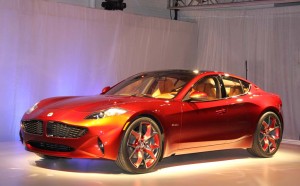
Don't expect to see the Fisker Atlantic get into production unless a White Knight emerges for the troubled battery-car maker.
Barely a week after U.S. employees were put on a 5-day unpaid furlough, troubled Fisker Automotive has apparently given termination notices to as much as half or more of its staff – including its entire communications department, several well-placed sources have told TheDetroitBureau.com.
While the latest move appears to be part of a desperate move to conserve dwindling cash resources while searching for new investors or a complete outside acquisition, the situation could be even more dire.
“I would not be surprised to see this leading up to the possibility of a bankruptcy filing,” cautioned an extremely well-connected source with long connections to the battery-car maker. Other Fisker sources said such a move would come as no surprise to them, either.
The mass job cuts are just the latest setback to a once-promising company that had hoped to become a major player in the nascent electric vehicle market. It was founded by two industry veterans, Bernard Koehler and the eponymous Henrik Fisker, a Danish designer who was perhaps best known for his work at Aston Martin.
Fisker himself tendered his resignation just last month, citing “several major disagreements” with members of the small carmaker’s senior management team over its ongoing business strategy.
But that was just one of the problems Fisker has faced since it launched sales of its first product, the Karma plug-in hybrid sports car, in early 2012. The Karma has been subject to several recalls for a variety of problems including a defective fan system that caused one vehicle to burn up. Meanwhile, production of the battery-car at a plant in Finland has been on hold since last autumn.
The more serious problem, echoed by numerous sources, has been one of “conserving cash” even while Fisker Automotive has struggled to find funds to replace much of a promised $529 million loan that was frozen by the U.S. Department of Energy after the carmaker missed key early targets.
Former Chairman Henrik Fisker previously told TheDetroitBureau.com that his company had raised “over” $1 billion from private investors, including the Silicon Valley venture capital giant Kleiner Perkins Caufield Byers, but still didn’t have enough to complete the development and tooling for a critical second product. The production date for the smaller, lower-cost Fisker Atlantic has had to be repeatedly pushed back, the latest estimate targeting sometime in late 2014.
As the big gun among investors, Kleiner Perkins has reportedly been taking an increasingly aggressive position in managing Fisker, first bringing in former Chrysler CEO Tom LaSorda for a brief assignment as Fisker chief executive, then turning to Tony Posawatz, the one-time head of General Motors’ Chevrolet Volt project.
Several other highly-regarded industry leaders reportedly turned down the job fearing Fisker’s financial problems.
In recent months, it has been widely reported that Fisker was seeking new money from several possible Chinese partners, including Dongfeng Motor Corp., based in Wuhan, China, which reportedly had considered purchasing 85% of the U.S. company. Also reportedly in talks was Zheijangg Geely, the Chinese firm that owns Swedish automaker Volvo.
Some sources indicate that both Chinese firms have pulled out of the discussions – though one insider cautioned, “The Chinese play hardball and may be taking advantage of the situation to get their best deal.”
It remains to be seen what Fisker Automotive could accomplish after slashing such a large portion of its staff, though it is almost certain work on the Atlantic would be completely idled. The likelihood is that the company’s investors simply want to hold on while they search for new capital, a buyer – or are forced to put the company in bankruptcy.
Officials from Kleiner Perkins and Fisker Automotive have so far failed to return calls regarding the latest developments. Henrik Fisker declined comment.
